We Embrace Transparency
Transparency is one of the pillars of the culture of our company. In this light, we want to describe how we make our Tea’d Greens. Considering that we (chose to) follow the ancient tea making techniques that are practiced in China this will also be a bit of a primer on how tea is made in general.
How It's Made From Our Fields to Your Cup
Experience the Meticulous Artistry of Tea Production on Our Farm
Honoring Traditional Roots
Tea-making Equipment and Mentorship
All of our tea making equipment comes from China. We worked through the different logistics of ensuring the equipment would be compatible with our process as we were not starting with the traditional tea leaf but rather the young green leaves of barley, wheat and oats.
To this end we want to give full credit to our Chinese contact, Chois, who worked tirelessly and patiently with us to develop our process. He also became our guru on all things tea and we are forever grateful for his mentorship.
Understanding Tea Terminology: Oxidation vs. Fermentation
I will use the terms oxidation and fermentation interchangeably in my descriptions. For clarity, all tea, except Pu’er tea is oxidized not fermented. For some reason the tea industry uses both terms when discussing tea processing. For a deeper explanation see our blog on fermented vs oxidized.
We continue to discover the art of making tea that comes from the wisdom of experience. Through trial and error combined with our quest to make the best tea we can guides us in the discovery of the tiny details that can make such a big difference. I suppose this applies to many things in life. In any event, here are our processing steps.

From Field to Facility: Harvesting and Transporting Fresh Leaves
As noted we start with the fresh young green leaves of barley, wheat and oats (see Our Farm for details about our farming practices).
The lush leaves are hand harvested from our fields and transported within minutes to our on farm processing facility.
The dedicated building is a steel and fabric building we purchased from a company in the Netherlands that creates an insulated space with a high ceiling and a bright airy atmosphere.
Beyond the Harvest: The Journey of Crafting
-
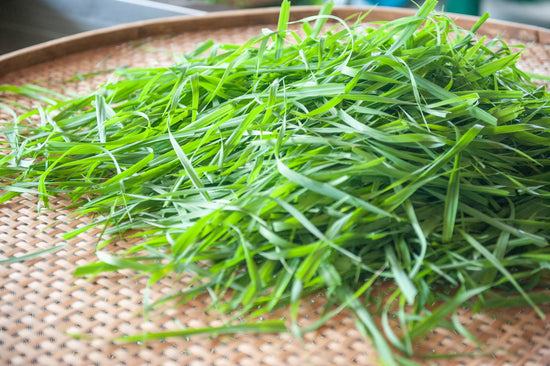
Withering
The first step the leaves undergo is withering. This is accomplished by placing the fresh cut leaves on large bamboo trays that are stacked and then placed in a cool and ventilated room. The timing of this step depends on many factors including the relative humidity and temperature of the air. As the leaves begin to release some of their moisture the air is filled with the appealing fresh scent of the green leaves. This step is important to the subsequent processing as the leaves become soft as the moisture is released.
If we are making Oolong tea, a further step after withering is undertaken in a “shaking drum”. On the bamboo trays the leaves are calm. However, as Oolong is partially oxidized we need to initiate the enzymatic process that begins as oxygen comes into contact with the juice inside the leaves. The drum gently scores the leaves as they are tossed thereby releasing more moisture and accelerating the oxidation process.
-
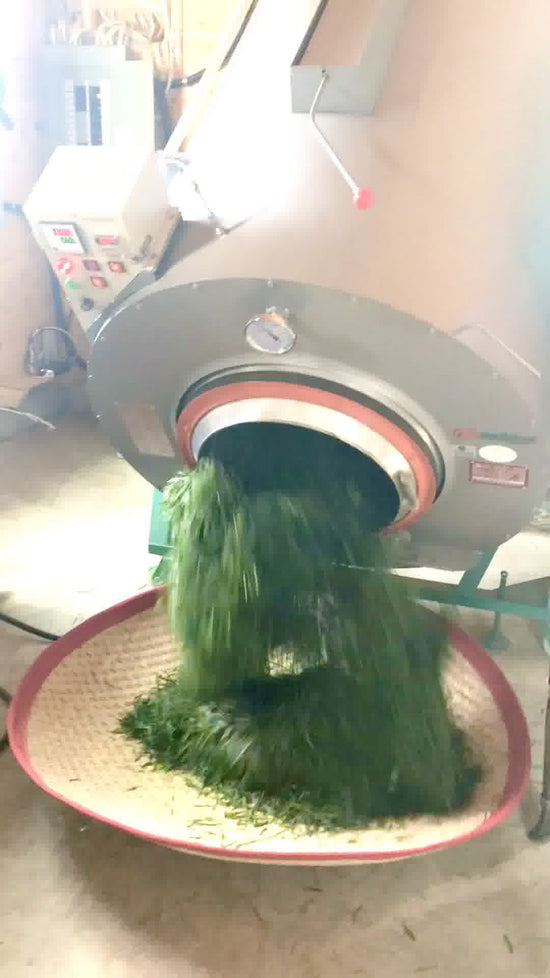
Fixation
The next step for Green and Oolong tea is fixation. The leaves are placed in a rotating drum and indirectly heated for a very short time to a high temperature. This stops the enzyme activity that is naturally occurring in the leaf which arrests the oxidative process. This is important as it preserves nutritionally valuable nutrients like the flavonoids and polyphenols that are abundant in the leaf; this also retains the dark green colour of chlorophyll.
As Black tea is fully fermented it does not undergo fixation.
-
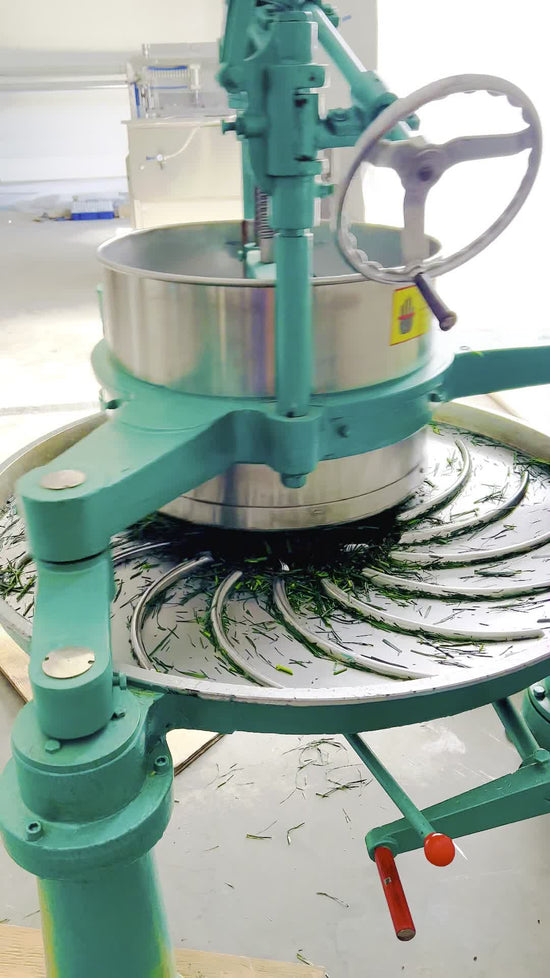
Rolling
The leaves are then allowed to cool before undergoing the rolling step. A tea roller is an interesting piece of equipment that many years ago replaced the need for hand rolling. Depending on which tea we are making the rolling step takes on a different role. For Green and Oolong tea it mainly shapes the leaf while breaking down the cell wall in the leaf which allows the nutrients to be more easily expressed during steeping. However in Black tea, as the leaf has not undergone fixation, the rolling step twists and breaks the cell walls in the leaf which further exposes the enzymes, tannins and other nutrients to the air to enhance oxidation. The degree of twisting determines the colour and taste of our Black tea and is an example of where the art of tea making shines bright. Interestingly, the tea industry does not have a standard time, or markers for the length of time Oolong and Black tea should be oxidized…hence the differences that can be found in different teas of the same variety.

Fermentation
Black Tea Inspired Greens
An additional step when we are making Black tea is fermentation(there’s the interchange again). Once the leaves are fully rolled they are placed in a machine that exposes the leaves to maximum humidity in a warm environment.
This is the perfect controllable environment that allows the leaves to continue to ferment. There is a noticeable change in the smell and colour of the leaves combined with a shift in the nutrient composition that comes from the oxidation of the phenolic compounds into catechins, flavanols and theaflavins to name a few.
Analyzing Phytonutrients: Unlocking Our Tea's Secrets
NB: We have undertaken a project in conjunction with the British Columbia Institute of Technology’s Natural Health and Food Products Research Group to analyze the green leaves in our Green, Oolong and Black tea for specific phytonutrients and amino acids and what compounds are developed through the stages of oxidation. This is exciting work that has not be undertaken before and we will be sure to share the results.
-
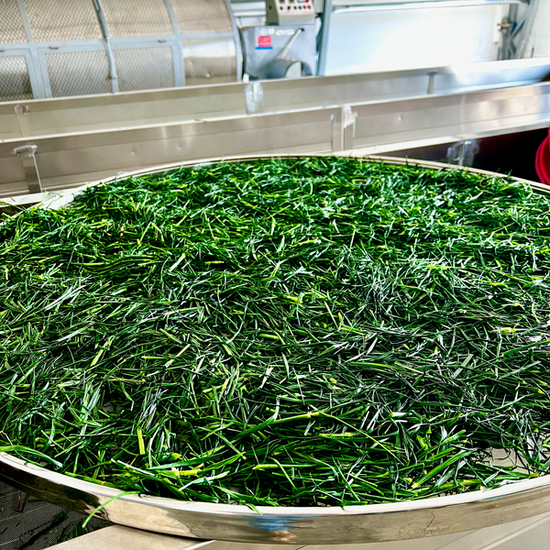
Drying - The Finishing Touch for Perfect Leaves
The final step of the process is drying. The leaves are placed on large racks in a drying machine where we control the amount of moving air, gentle heat and time. This allows for the final amount of water to be evaporated from the leaves thereby stabilizing the leaf, maximizing nutrient retention and in the case of Black tea the cessation of oxidation.
This initial process takes between 8 – 12 hours, depending on the variety.
-
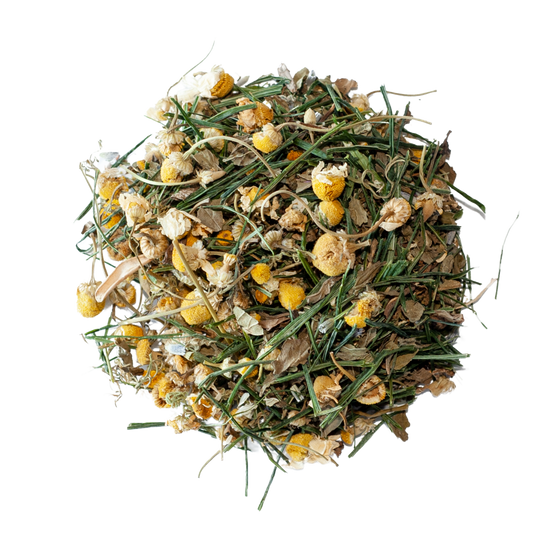
Quality Assurance & Herb Sourcing
After the leaves are dried, they undergo food safety testing and once passed, will then be used in our different blends.
We work with different farms from all over to source the organic herbs that go into our blends. We ensure we have proper documentation for organic certification, purity and safety from all of our herb suppliers.
-
Blending and Packaging - Crafting the Perfect Tea Experience
The very last step also takes place in our own facility which is the blending and packaging of our tea into either non-plastic biodegradable pyramid tea bags or biodegradable bags for loose leaf orders. Once completed the tea is shipped to our customers.
The entire process from seeding, harvesting, processing and packaging all takes place on our farm. This allows us to control each step which compliments are demand for quality and transparency.
If you have any questions about our farm, manufacturing process or tea never hesitate to send us a message and we will be sure to respond to your inquiry.




